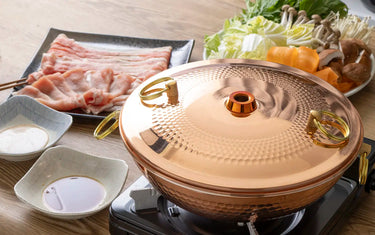The product we used:
What is Shabu Shabu?
Shabu shabu is a meal where everybody takes thinly sliced meat (typically pork, maybe beef) or vegetables, and cooks each slice individually by dipping them in hot soup. The shabu shabu pot is typically placed at the table and everybody there cooks for themselves and eats the freshly cooked food right away, similar to yakiniku. The main difference between yakiniku and shabu shabu is that with yakiniku, you grill the food (and there is typically a greater variety of ingredients), whereas with shabu shabu you boil or poach the food.
How to Choose the Right Pot for You
Because of the social style of cooking shabu shabu and the necessity to cook food quickly, choosing the right pot is an important consideration before getting started with cooking. The ideal shabu shabu pot has the following characteristics:
- Food can be cooked comfortably in the pot while sitting at the dinner table.
- Food cooks evenly and at roughly the same rate for the entire meal.
With that in mind, here are a few things to keep in mind when choosing your shabu shabu pot.
Shape

Shabu shabu pots, in addition to being both short and wide to allow for easy social cooking at the dinner table, can sometimes have a special “chimney” in the middle. The chimney provides more surface-area for the stove to heat the liquid. That means the soup will heat up faster and won’t cool down as quickly. The end result is that you and your family get to cook faster and your food will cook evenly throughout the meal.
Of course, non-chimney style shabu shabu pots are popular too. Chimney pots are specialized for shabu shabu and require a bit more work to clean, making them appropriate for families that really love their shabu shabu. Standard shabu shabu pots can be used like any other pot and are easier to clean.
Material

There are two standard materials for shabu shabu pots: copper and stainless steel. Copper is a better conductor and holder of heat, meaning your soup will stay hot and cool down more slowly. Stainless steel is still a fine material, but you may need to watch the temperature more closly to prevent the soup from getting too cold.
One downside to copper is that it will require a bit more maintenance compared to stainless steel. Copper typically requires a special cleaner to clean off oxidation.
Size

Shabu shabu is a social meal, so getting the size right is critical for a happy shabu shabu meal with your family. In general, pots between 20-24cm wide (approximately 8 or 9 inches) are considered suitable for 1-2 people, whereas pots 25-27cm (10 or 11 inches) are considered suitable for 3-5 people.
Making Shabu Shabu
Once you’ve got the right pot, you can get to cooking. A basic shabu shabu ingredient list is very simple:
- Dashi
- Thinly-sliced meat
- Thinly-cut or sliced vegetables
Prepare Ingredients


First, you need dashi. The typical dashi is very simple: boiled water with seaweed (kombu). The dashi is simple because the added flavors are going to come later.
Next, you need thinly sliced meat and vegetables. The most common meat used in shabu shabu is pork, but beef is also a popular shabu shabu meat.
Finally, you need vegetables. Typical vegetables include Chinese cabbage and shiitake and enoki mushrooms. Cabbage will cook quickly, and the mushrooms will add their own flavors to the dashi as they sit and cook.
While it’s less typical, we also cooked sliced carrot for our pictures to give you more ideas for what you can do with shabu shabu.
Cooking


To cook, first heat up the dashi. Once you bring it to a boil, turn the heat to medium-high to reduce the boiling.
Now it’s time to jabu-jabu your shabu-shabu. Take some meat or vegetables with some chopsticks, dip and swirl them around in the hot dashi until they are cooked to your liking. Traditionally, Japanese swish the meat (ideally fresh meat) around three times. Under those conditions, the meat will still be a bit pink and soft on the inside. However, if you’re not confident in the freshness of your pork, then a rule-of-thumb would be to dip it in the dashi for about 10 seconds.
For vegetables, again, it’s up to you.
Mid-meal cleanup

While cooking, the meat will tend to leave behind some fats and proteins floating on top of the dashi. From time to time, it’s a good idea to scoop out those fats and proteins to clean up the dashi and maintain a clean, fun shabu shabu meal.
Eating Shabu Shabu

Cooked shabu shabu meats and vegetables are typically dipped in some sauce or dressing–again, similar to yakiniku. Shabu shabu is intended to be a lighter food that relies more heavily on the flavors of the fresh ingredients used. Thus, tsuyu and sesame dressing are two popular, light dips. However, you can feel free to experiment with other kinds of dips, like salt/pepper, bbq sauce, yakiniku sauce, etc.
More Ideas
While thinly-sliced meats, chinese cabbage, and mushrooms are the most common foods, there are some more foods that you can try cooking.
- Green onions
- Tofu
- Udon
- Harusame (glass noodles)
The udon and harusame are typically cooked in the dashi after most of the other ingredients have been eaten. If you don’t want to carb up with noodles, then a simple bowl of rice is a perfectly acceptable substitute.
Stay Warm!
If you’re looking for other meal ideas to help you and your family stay warm this winter, you might be interested in Grandma’s Battle-Tested Sukiyaki Recipe or How to Make Classic Roasted Sweet Potatoes. If you plan on cooking outdoors, you might also be interested in learning about Cooking Outdoors with Mess Tins.














